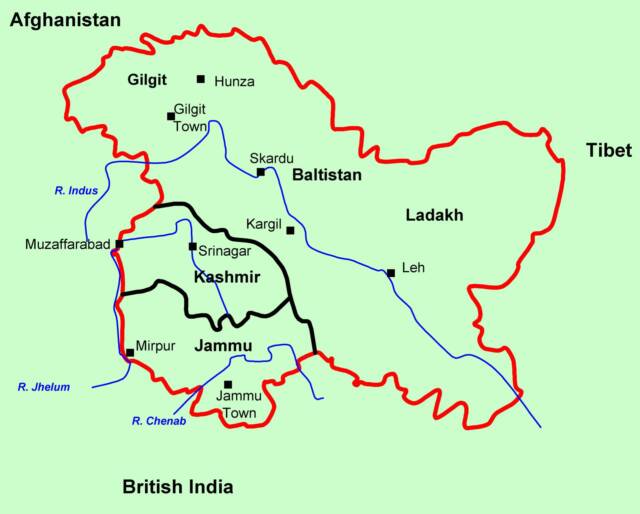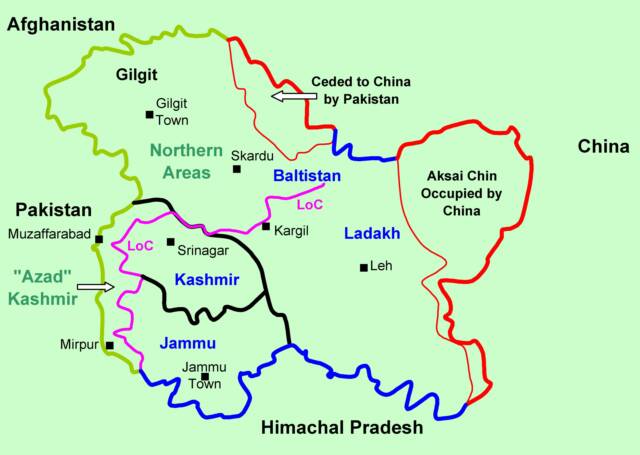Jammu and Kashmir: In the Shadow of Imperialism Home
Maharaj K. Kaul
[Taken from Essays in Inequality and Social Justice (Essays in honor of Ved Prakash Vatuk), Edited by Kira Hall, Archana Publications, Meerut, India, 2009]
RELIGIOUS AND ETHNIC DIVERSITY IN JAMMU AND KASHMIR
Gulab Singh’s state of Jammu and Kashmir was made up of three main geographical regions: Ladakh-Gilgit province in the north and north-west; Jammu province in the south; and Kashmir Province in the middle (see Map 1).
The 1947 war between India and Pakistan led to the division of the state, with Pakistan occupying western Baltistan and the Gilgit region (which Pakistan calls the Northern Areas) and the western parts of the Jammu and Kashmir regions between Muzaffarabad and Mirpur (which Pakistan calls Azad Kashmir). The line separating the Pakistan-occupied area and the remainder of the state, which is part of the Indian Union, became the cease-fire line on January 1, 1949 (see Map 2). Later, at the July 2, 1972 Simla meeting between the Prime Ministers of India and Pakistan, the cease-fire line was renamed and converted to the Line of Control (LoC).
In addition to these developments involving Pakistan, the Chinese occupied the uninhabited eastern part of Ladakh during the 1950s to enable them convenient access to Tibet, which they had earlier forcibly occupied. In 1963, Pakistan ceded the area of the Shaksgam Valley (near the Siachen Glacier) to the Chinese. By late 1963, then, Jammu and Kashmir State, which had acceded to India’s control in 1947, was divided and under illegal occupation by both Pakistan and China, a situation that has not changed since.
The breakdown of the state’s current population, according to the 2001 Census of India and the 1998 Census of Pakistan (extrapolated to 2001), is given in Table 1.
TABLE 1. Geographical regions and population of the undivided state of Jammu and Kashmir
The killing and expulsion of all Hindus and Sikhs from Pakistan-occupied Kashmir (henceforth called PoK) destroyed much of the state’s religious diversity, though the state continues to be ethnically diverse.
Diversity in the Indian State of Jammu and Kashmir (JKI)
The remainder of the state that is a part of the Indian Union (henceforth called JKI), maintains religious as well as ethnic diversity. Muslims continue to be a majority in JKI: they constituted about 75% of the population of an undivided Jammu and Kashmir in 1947 and make up approximately 67% of JKI’s current population. The population of JKI, according to the 2001 Census, is 10.14 million. Table 2 shows the areas of three distinct geographical regions of JKI and their respective populations.
TABLE 2. Proportion of area and population for different regions of JKI (in percent of total)
Population percentages in the table are based on the Census of India 2001. The table does not take into account the exodus of the Hindu religious minority from Kashmir to Jammu that occurred in and after 1990, which involved about 2.5% to 3% of the population of the state.
The linguistic composition of JKI is shown in Table 3. The numbers, based on the 1981 Census of India (Warikoo 1996), are percentages of the total population of the state. There is also a correction for the migration of Kashmiri-speaking religious minorities from Kashmir to Jammu in the 1990s.
TABLE 3. Regional breakup of different linguistic groups in JKI (in percent of total population)
Finally, the regional, ethnic, and sectarian makeup of JKI is given in Table 4. 1 The population of Muslims is divided along the lines of sect and ethnicity because these divisions illuminate the population source of separatist sentiment in JKI, which derives its strength from the various groups of non-pastoral Sunnis of the Kashmir Valley. Among these separatist groups, the most vocal is the middle class urban group concentrated in Srinagar and its immediate environs. Hindus, Sikhs, Buddhists, and Christians, regardless of their ethnicity or caste division, stand unequivocally for union with India. (Besides the groups listed in these tables, there are a number of other smaller ethnic groups, such as Pothwari-speaking Muslims and non-Muslims, Chibalis, and Gaddis.)
TABLE 4. Regional breakup of religious groups in JKI (in percent of total population)
The largest religious sect in JKI is Sunni Islam, whose followers constitute about 44% of the state’s population and about 32% of the Valley’s population. The largest ethnic group is Kashmiri-speaking: Kashmiri speakers in the Valley alone account for approximately 41% of the state’s total population. Those who belong to both of these groups—i.e., Sunni and Kashmiri-speaking—constitute about 25% of the state’s total population. Valley-based Kashmiri-speaking Sunni Muslims, as the largest of all of these groups, have dominated the politics and administration of the state, playing a critical role in shaping the events that have led up to the present turmoil.

MAP 1:
The Princely State of Jammu and Kashmir at the time of the partition of India in 1947.
Three geographical regions (Ladakh-Baltistan-Gilgit, Kashmir, and Jammu),
major rivers (Indus, Jhelum, and Chenab), and prominent towns are shown.
The northern area of the undivided Jammu and Kashmir state—the Greater Gilgit and Tribal Areas and the Ladakh-Baltistan region—is a high altitude region with Leh in the east at an elevation of 11,000 feet, dropping along the path of the Indus river to an elevation of 5,000 feet in Gilgit to the west. The southern part of Jammu is at an elevation of 1,000 feet, providing a transition between the high mountain ranges in the north and the plains of Punjab in the south. Sandwiched between the northern and southern areas is Kashmir, with a flat valley in the middle known as the Valley of Kashmir. Constituting an area of approximately 2,000 square miles, Kashmir is drained by the river Jhelum and has an almost uniform elevation of 5,500 feet.
The ethnic diversity of the state mirrors its geographical diversity to a large extent. In the eastern part of Ladakh-Baltistan-Gilgit, the regional people are by and large of Tibetan stock and are Buddhists or Muslims by religious persuasion. Muslims are divided into Shias (predominant in Purik and Baltistan); Ismaelis, another sect of Shia Islam (predominant in northern Gilgit and Ghizer district); and Sunnis (predominant in the southwest in Chilas and Astore). The main Gilgit town and surrounding valleys are thickly populated with Shias, while Buddhists tend to reside in Central Ladakh in the Indus Valley and surrounding areas. The languages spoken in this region are Balti, Bodhi, Borushaski, Chitrali, Hindko, and Shina. In Jammu and to its immediate east, the population is predominantly Hindu, while the western parts of Jammu are predominantly Muslim. The languages spoken in this region are Dogri, Gujari, Pahari, Pothwari, and Punjabi. In addition, the eastern section of Jammu houses pockets of Pogli-Kashtawari (Kashmiri) and Bhadrawahi, as well as sub-pockets of Siraji and Rambani. Residents of the Valley are Kashmiri-speaking and primarily Muslim, either Sunni or Shia, though a small percentage are also Hindu, Sikh, or Christian. Straddling the Kashmir Valley and the foothills of Jammu is the abode of the Gujjar/Bakarwal tribes, the shepherd community of the state who speak Gujari, a kin of Rajasthani Hindi. They are generally Muslim.

MAP 2:
Jammu and Kashmir State in 2009
Region

 Area
Area
 Population
Population
__________________________________________
Ladakh 22,836 0.237
Jammu 10,152 4.430
Kashmir 6,158 5.477
__________________________________________
39,146 10.144
__________________________________________
Northern Areas 25,026 0.945
'Azad' Kashmir 5,134 3.194
__________________________________________
30,160 4.139
__________________________________________
Aksai Chin 14,500 0.000
Shaksgam 2,000 0.000
__________________________________________
16,500 0.000
__________________________________________
Total 85,806 14.283
__________________________________________
Region

 Area
Area
 Population
Population
__________________________________________
Ladakh 69.95 2.33
Jammu 18.93 43.68
Kashmir 12.42 53.99
__________________________________________
Total 100.00 100.00
__________________________________________
Language Kashmir Jammu Ladakh Total
___________________________________________________________________
Kashmiri 41.37 7.98 0.02 49.37
Dogri 0.05 24.24 0.00 24.29
Gujari 7.26 12.82 0.00 20.08
Ladakhi (Bodhi) 0.01 0.02 1.17 1.20
Balti 0.01 0.00 0.78 0.79
Punjabi, Pothwari, Shina, etc. 1.16 2.85 0.26 4.27
___________________________________________________________________
Total 49.86 47.91 2.23 100.00 ___________________________________________________________________
Region Ethnicity/Language Shia Sunni Others Total
Ladakh Balti 0.78 0.78
Bodhi, Shina, etc. 0.25 1.20 1.45
2.23
__________________________________________________________________
Jammu Gujjar/Bakarwal 10.64 2.18 12.82
Other Muslims 1.25 1.60 2.85
Others 32.24 32.24
47.91
__________________________________________________________________
Kashmir Kashmiris 16.77 24.60 41.37
Shina, Balti, etc. 1.18 1.18
Gujjar/Bakarwal 7.26 7.26
Others 0.05 0.05
49.86
__________________________________________________________________
(*) Others are Hindus, Buddhists, Sikhs and Christians